For P2 Science, I wrote this article in Personal Care Global on the performance of Citropol® F, a polycitronellol variant, as a fragrance fixative. Citropol® F is derived from renewable sources using a process based on green chemistry. We used GC measurements and sensory observations to show that this material prolongs the duration of fragrance perception more than competitive alternatives.
This article illustrates how we can generate scientific data to support the performance of new materials.
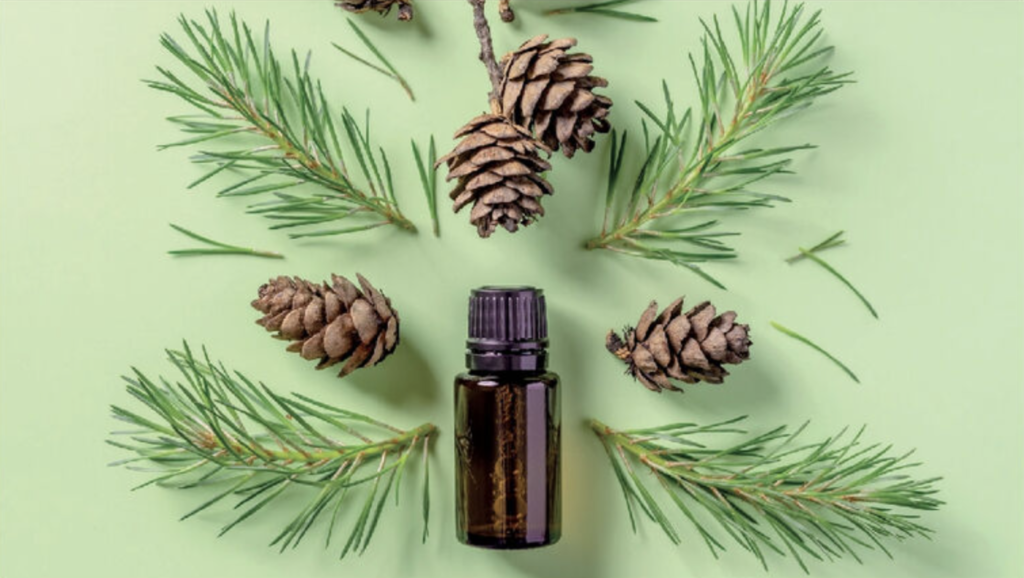
Delano Wood, Tania Salam, Patrick Foley (P2 Science Inc., Woodbridge, CT)
Marc de Mul (Measured Innovation LLC, Weston, CT)
Summary
Citropol® F (Polycitronellol) is a new fragrance enhancer derived from renewable sources using a process based on green chemistry. We use GC measurements and sensory observations to show that this material prolongs the duration of fragrance perception more than competitive alternatives.
Introduction
By their nature, fragrances are fleeting. Their purpose is to evaporate and reach the olfactory receptors in our nasal passages. But product designers are often aiming for a persistent scent that doesn’t dissipate after initial perception. This can be achieved in 3 ways – continuously generating new fragrance molecules, as flowers do; controlling release of the fragrance molecules by encapsulation or other means; or lowering the vapor pressure of the fragrance ingredients, so that they don’t volatilize as quickly.
A fine fragrance is generally composed of top, middle, and bottom notes, along with a volatile solvent (often ethanol) and a fragrance fixative system. After application to skin, the solvent and top notes evaporate quickly, leaving behind the middle and bottom notes and the fragrance fixative. The rate of evaporation of a fragrance component is proportional to its partial vapor pressure, which is proportional to its concentration in the mixture according to Henry’s Law, first formulated by William Henry in an 1803 publication.1
This law applies to dilute solutions of volatile ingredients. In concentrated fragrance mixtures, fragrance ingredients interact with the other mixture components, which affects their vapor pressure. These interactions can be described in terms of the thermodynamic activity coefficients of the individual ingredients.2 The activity coefficients can be calculated with interaction models such as UNIFAC, UNIQUAC, and COSMO-RS. Such models calculate the activity coefficients based on the contributions of the chemical composition of an ingredient and the entropy of mixing due to an ingredient’s molecular shape.
In an evaporating fragrance, the mixture composition changes, which changes the ingredient activities. The partial vapor pressures of each ingredient will change with the mixture composition. The function of a fragrance fixative is to reduce the partial vapor pressures of the remaining fragrance components on skin by decreasing their activity coefficients. This means diluting them and altering their intermolecular interactions. This lowers the evaporation rate of those fragrance components, thus prolonging their presence.
An effective fragrance fixative slows evaporation of the top and middle notes throughout their residence time on skin. The fixative should provide good solubility to the fragrance components as they progressively become more concentrated. The fixative itself should be non-volatile and odorless or nearly so – if the fixative has a perceptible scent, it needs to be integrated into the overall fragrance profile. Preferred fixatives dissolve fragrance ingredients without forming a sticky or greasy film on the skin.3
Lowering vapor pressure and hence volatility is not the whole story, however, because some fragrance ingredients can also be absorbed into the skin.4, 5 Most fragrance fixatives have negligible skin absorption. They may form an oily film on the skin after most of the fragrance has evaporated. If present, this hydrophobic film can further retard evaporation of the remaining fragrance ingredients – the bottom and middle notes.
Traditionally fragrance fixatives have been natural materials such as resins, musks and ambergris. The latter are animal-derived and rarely used anymore. Modern fixatives are synthetic musks (e.g. galaxolide), essential oils (e.g. patchouli and sandalwood), and synthetic polymers (e.g. cyclodextrins and silicones). Many more examples can be found in the patent literature.6, 7 The musks and essential oils are not odorless and should be formulated as part of the fragrance. Cyclodextrins encapsulate the fragrance molecules to retard their evaporation, but they are very polar and not suitable for all ingredients. Silicones work well, but don’t biodegrade and accumulate in the environment after use.
Polycitronellol is a new fragrance additive that possesses fixative and odor masking properties. It is derived from natural pine-derived terpenes by a manufacturing process based on the principles of green chemistry.8 This material provides hydrolytic stability while being 100% biorenewable, bioderived, biodegradable and biocompatible.9 In this article we will demonstrate the performance of Polycitronellol as a fragrance enhancer. We will show that it outperforms competitive materials. Polycitronellol can be used as a fragrance ingredient, but it can also be added to finished product formulations to prolong the fragrance presence.
Experiments
Test fragrance formulation
The compositions of the test fragrance formulations are given in the text. All chemicals were obtained from Sigma-Aldrich, except Glucam P20 (PPG-20 Methyl Glucose Ether, Lubrizol) and Anthamber (Tetramethyl acetyloctahydronaphthalenes, VIGON). Polycitronellol was provided by P2 Science; it has a very light odor that only impacts the fragrance at high concentrations.
Analytical evaporation test
This test measured the effect of fragrance fixatives on the evaporation rate of fragrance molecules over time at a set temperature in a model fragrance formulation. A measured amount of formulation mixture was transferred to an aluminum container and placed on a hot plate at 32 °C for evaporation. Mixtures were tested at pre-determined time intervals (i.e. 0 hours, 0.5 hours, 4 hours, and 6 hours) and extracted.
A gas chromatograph (GC) measured the amount of fragrance present in each sample quantitatively. An internal standard controlled for variation during the evaporation test. At each time point, the GC response (peak area) of fragrance material and internal standard were recorded. The ratio of fragrance and internal standard was calculated and corrected by a calibration factor. The first time point at 0 hours was set as non-evaporated fragrance material. The evaporation of fragrance molecules over time compared to the initial amount was reported as a percentage.
To compare the performance of fragrance fixatives, we used a model fragrance consisting of equal amounts of a top note (Dihydromyrcenol), heart note (Carvone), and base note (Anthamber) with fixatives set at a 10% composition. The test formulation was as in Table 1.
In a second test, we compared different levels of Polycitronellol between 0.5% and 10% in the fragrance (Table 2). In this testing, Anthamber was removed from the fragrance composition to ensure that fixation was provided primarily by Polycitronellol.
Table 1. Model eau de toilette formulation with different fragrance fixatives ( Polycitronellol, Sucrose Acetate Isobutyrate (SAIB), Glucam P20, Triethyl Citrate (TEC))

Table 2. Model eau de toilette formulation with different levels of Polycitronellol between 0 and 10%. Note: Anthamber was omitted from the model fragrance for these tests

Sensory evaluation
To test the performance of the selected fixative products, we conducted a sensory test that compared the effectiveness of 3 fixatives used at 2% in alcoholic solutions (Table 3). Blotters were dipped in the test samples, labeled with random numbers to avoid sampling bias, and left in an open space (25℃ ± 5℃) for a measured number of hours. Untrained panelists (n=10) evaluated the strength of each blotter on a scale of 0-10, with 10 being strongest, after 0 hours, 1 hour, 3 hours, and 6 hours. Panelists were asked to compare each blotter against rating given at 0 hours. The data was averaged and the fragrance strength reduction (%) compared to the control sample was plotted over time. The panelists provided their informed consent to participate prior to the test.
Table 3. Test eau de toilette formulations in comparative evaluation of fragrance fixatives

Finally, we conducted a directional difference test with a simple model fragrance composition containing Polycitronellol at different levels (Table 2). The test samples were applied to blotters as before. Untrained panelists (n=12) evaluated one of the test samples against a control sample and were asked to determine which blotter had the stronger fragrance. Any response that did not declare the Polycitronellol sample as stronger was counted towards the control (i.e., responses of “same strength”, “no odor”, “unsure”, etc.). We tested at 0,1, 2, 3 and 6 hours after dipping the blotters in the test samples. We calculated the percentage of panelists who judged the test sample stronger. Prior to the test, the panelists provided their informed consent to participate.
Table 4. Model eau de toilette compositions used in directional difference sensory test

Results & Discussion
We compared the ability to retain fragrance ingredients among different fixative materials by gas chromatography. To this end, model fragrances were prepared with a top note (Dihydromyrcenol), middle or heart note (Carvone), and base or bottom note (Anthamber). The fixative level was kept at 10% (Table 1). We measured the amount of top and middle notes remaining after aging for up to 24 hours. Figure 1 shows the ingredient levels after 6 hours.
After 6 hours, no Dihydromyrcenol was found in the control sample, which did not have a fixative. Some Carvone remained. Polycitronellol retained the most fragrance material for both Dihydromyrcenol and Carvone.
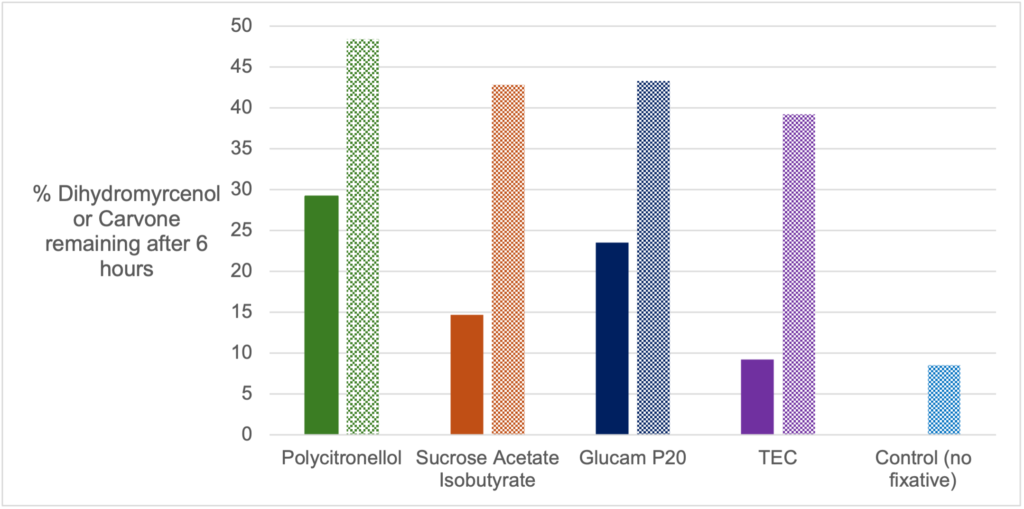
Figure 1. Polycitronellol retains more Dihydromyrcenol and Carvone after 6 hours compared to all other fragrance enhancers tested (Dihydromyrcenol indicated by the solid bars, Carvone by the patterned bars).
Lower levels of Polycitronellol retain less fragrance (Figure 2). After 4 hours of aging, 2% Polycitronellol still retains almost 35% of the Carvone and 17% of the Dihydromyrcenol that was present initially. The base note Anthamber was not present in these tests.
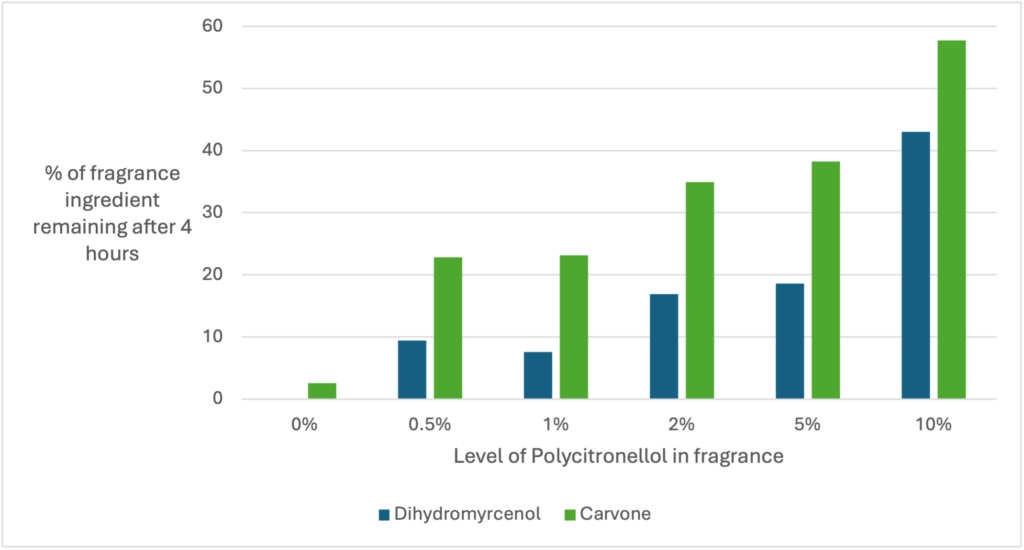
Figure 2. Dihydromyrcenol and Carvone levels in the model fragrance with different levels of Polycitronellol after 4 hours aging
In the next set of experiments, we used an untrained sensory panel to determine if the fragrance retention enabled by the fragrance fixatives was perceptible. Figure 3 shows the reduction in perceived fragrance strength from the initial strength after 1, 3, and 6 hours. All blotters with model eau de toilette alcoholic solutions containing fixatives were perceived as stronger than the control (a solution without fixative) after 1 hour aging. However, after longer aging times, panelists could no longer distinguish between blotters. The samples with Polycitronellol were directionally still stronger even after 6 hours, but this perception was not statistically significant.
However, the directional difference test showed that the panelists could detect the sample with the Polycitronellol with a high degree of confidence ( <0.05) for up to 3 hours aging for Polycitronellol levels between 2 and 10%. At 10% Polycitronellol, panelists could still distinguish the test sample from the control with a significance level a<0.05 (Figure 4).
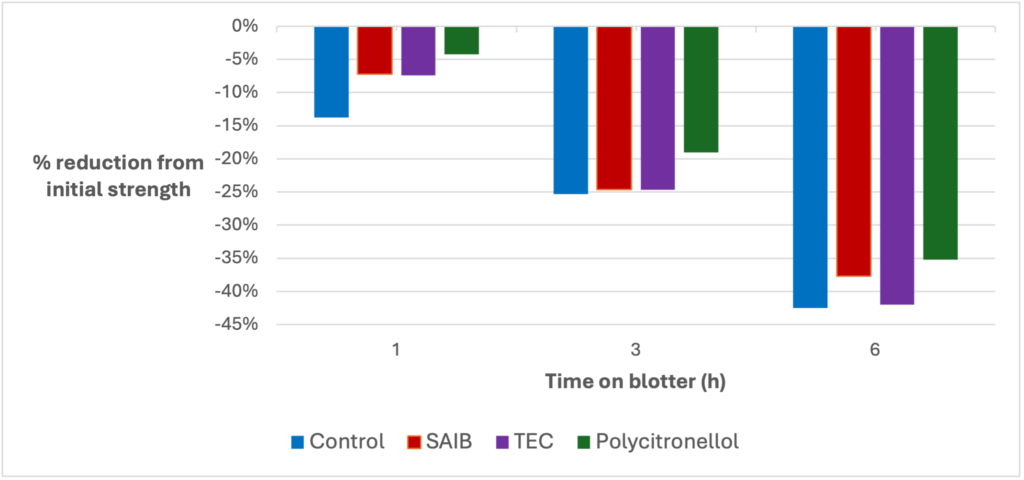
Figure 3. Reduction of perceived fragrance strength from initial perception for different fragrance enhancers, each at 2% in alcoholic solution
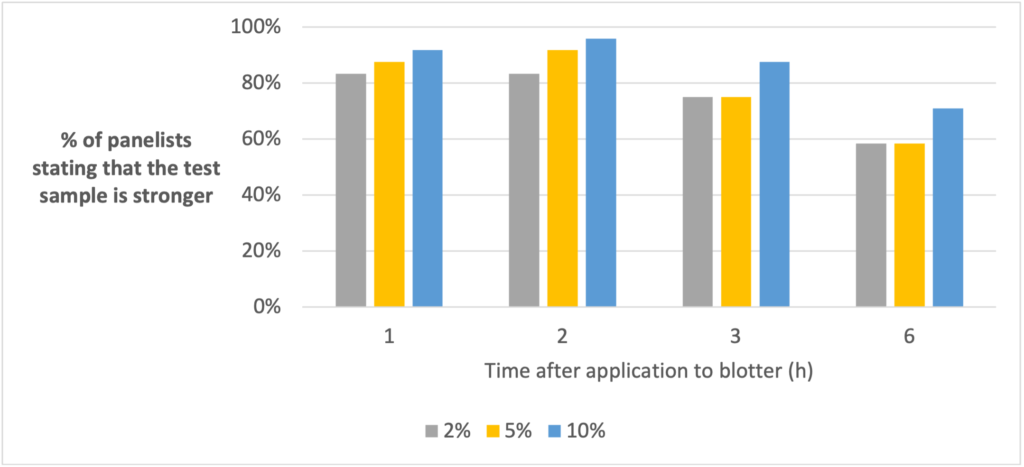
Figure 4. Perceived fragrance strength in directional difference test for 2, 5, and 10% Polycitronellol in the model eau de toilette as a function of aging time. A 50% result means that the panelists could not distinguish between the test sample and the control sample (no fixative).
The experimental results prove that Polycitronellol is effective at retaining Dihydromyrcenol and Carvone in a model fragrance applied to a blotter for at least 6 hours. Other results which we have not shown due to space constraints indicate that Carvone is detectable by gas chromatography after 24 hours aging in samples with Polycitronellol. The increased fragrance retention is perceptible by untrained panelists. A level of 10% Polycitronellol in the fragrance is most effective, but lower levels have benefits for shorter aging times. Polycitronellol outperformed the other fragrance fixatives tested.
Conclusion
Polycitronellol (Citropol® F) is an effective fragrance fixative for over 6 hours after fragrance application. It outperforms the other fragrance fixatives tested. The fragrance is perceptibly stronger with Citropol® F as determined by an untrained sensory panel.
The authors would like to thank Dr. Johan Pluyter for improving the manuscript.
References
- W Henry, “Experiments on the quantity of gases absorbed by water, at different temperatures, and under different pressures”, Phil. Trans. R. Soc. Lond. 93: 29–43 1803).
- SM Walas, “Phase Equilibria in Chemical Engineering”, Reed Publishing, 1985.
- Fragrance Fixatives – The Key To Longer Lasting Fragrances, Alpha Aromatics blog post, February 20 (2023).
- BD Mookherjee, SM Patel, RW Trenkle, RA Wilson, “A Novel Technology to Study the Emission of Fragrance from the Skin”, Perfumer & Flavorist 1998, 23 (1/2), 1-11.
- P Saiyasombati, GB Kasting, “Prediction of Fragrance Headspace Concentrations from Physico-Chemical Properties”, Perfumer & Flavorist 2004, 29 (7/8), 38-47.
- LAM Holland, CMS Bonnet, F Pastor, JM Velazquez Mendoza, JR Stonehouse, WE Staite, DT Stanton, O Todini, SKK Nyakana, S Fernandez Prieto, J Smets, JJ Scheibel, I Guimet, “Fragrance Fixatives and Compositions Comprising Thereof”, US Patent Application 2019/0376001 A1 (2019).
- A Saint-Paul, E Perrotta, JM Velazques Mendoza, SKK Nyakana, World Patent WO 2023/055927 A1 (2023).
- P Foley, “Polycitronellols Reinvent Green, Sensorial Chemistry and Cosmetics”, Cosmet. Toil. 2023, 26-29/DM5-DM8.
- A MacKenzie, P2 Science Launches Fragrance Fixative: Citropol® F, Perfumer & Flavorist 2020, June 10 (2020).
